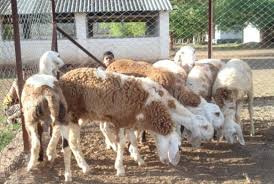

“With 80% of lamb performance based on a farmer’s management and only 20% on feeding, there’s a lot a farmer can do to ensure optimal growth,” Hamlett a researcher says.
“A lamb’s life actually begins four to six weeks before it is born. About 80% of foetal development occurs during this phase, so it’s crucial to pay special attention to a ewe’s feed requirements then,” says Hamlett.
As the foetus grows larger, the ewe’s rumen capacity decreases. Contrary to what many believe, smaller rumen capacity does not mean that a ewe should be fed less. In fact, the farmer has to feed a ewe more concentrated feed during the final stages of pregnancy.
“Concentrated feed is utilised better. One also needs to provide good roughage, such as lucerne, at this stage, and a good bypass protein,” he says.
A bypass protein is not digested in the rumen by bacteria; instead, it makes its way to the small intestine, where it is absorbed.
Post-birth
According to Hamlett, research has shown that between day one and day 42, a lamb has a feed conversion ratio of 1:1. This means for every 1kg it eats, it grows 1kg. From day 43 to day 60, this changes dramatically to 3:1, with 1kg grown for every 3kg feed consumed.
From day 60 to day 80, this can be about 3,5:1. After this, between 4,5:1 and 5:1 is normal.
For maximum growth, it is essential that the lamb has an adequate intake of colostrum immediately after birth, followed by creep feed.
“Colostrum, with its high level of antibodies, is a lamb’s first line of defence against disease. After colostrum intake ends, you should provide creep feed from day seven of a lamb’s life until 14 days after weaning, if you wean at 100 days,” says Hamlett.
This not only accustoms the lamb to eating solid feed, but enables it to react better to weaning shock. Creep feed should contain at least 19% protein at this stage.
“Protein in creep feed has to be high to ensure muscle build and normal development, and to optimise feed conversion. Colostrum and creep feed allow the digestive system to develop well, which in turn ensures that the animal will grow well at later stages of its life,” he says.
Feeding regime
“Lambs are usually sent to a feedlot at about 30kg and fed there until they reach a live weight of 50kg, after which they’re sent to the abattoir. For a lamb to grow, it needs to consume a ration larger than a maintenance ration,” Hamlett says.
As lambs are always grown out for slaughter purposes, data on how to maintain a lamb is rare. However, data on ewe maintenance rations is prolific. Although the needs of ewes and lambs differ, this data can give some insight into the feeding regime a lamb should follow to be grown out for slaughter.
A 50kg ewe needs 2% of her live weight in feed for maintenance. In a feedlot, lambs are fed 4% to 4,5% of their live weight a day to optimise growth. Such a ration should contain high levels of high-energy feed, which will lead to a higher feed conversion ratio.
It should also have a high protein content and a 10% to 15% bypass protein content. These proteins are found in fishmeal, oilcake and lamb feed, and contribute to lamb growth. A 50kg ewe also requires 95g of crude protein a day for maintenance. Lambs need at least 181g of protein for 300g/day growth over a 60-day growth period.
Hamlett recalls a client with a Mutton Merino herd that attained an average growth of 393g/day. The lambs did, however, have a head start with creep feed. Their growth diets also included lucerne and palatable roughage.
According to Hamlett, lambs that are weaned at 100 days at 33,6kg can attain a 4,5 to 5:1 feed conversion.
A month before weaning, a lamb’s feed intake is 50% milk and 50% feed. Creep feed is essential at this stage as it not only helps the transition to solid feed, but lessens weaning shock. A rule of thumb is that a lamb should receive between 25kg and 30kg creep feed from day one and day 100 of its life.
This translates to about 300g/day for the period. It should be noted, however, that a younger lamb will eat less and an older one more.
Management
Hamlett stresses that managing the transition from weaning to feedlot is critical, as it will help determine future success. Lambs that have adapted to creep feed before weaning will adapt more readily to feedlot conditions as they are used to high-energy foods that assist with growth.
Part of this management should involve monitoring the animals and ensuring that conditions in the pens are optimal. He suggests, for example, that even though the animals are fed only three times a day, the farmer walk through the feedlot five times a day.
“Before I begin feeding, I clean the feed troughs and remove any dung. Pills that were not eaten are fed again. Any meal that remains is taken out. I do this at 7.30am and again at 10am.
People say sheep are ‘allergic’ to their own saliva and avoid eating feed that they previously fed on. If you shuffle the feed around every few hours, it stimulates them to eat again.”
He adds that getting sheep to stand up also stimulates behaviour that leads to feeding, and recommends this as a management practice. Even pretending to put out fresh feed by waving a bag while stirring feed is helpful.
Water plays a major role in sheep production, and Hamlett stresses that cool, clean water should be provided ad lib. A single sheep can drink between 4ℓ and 10ℓ of water a day. “Have the water tested for heavy metals, as these can curb growth. Also test for E. coli.
 Contact Jaguza Support
Contact Jaguza Support